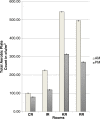Bioaerosol sampling for airborne bacteria in a small animal veterinary teaching hospital
- PMID: 23930156
- PMCID: PMC3737439
- DOI: 10.3402/iee.v3i0.20376
Bioaerosol sampling for airborne bacteria in a small animal veterinary teaching hospital
Abstract
Background: Airborne microorganisms within the hospital environment can potentially cause infection in susceptible patients. The objectives of this study were to identify, quantify, and determine the nosocomial potential of common airborne microorganisms present within a small animal teaching hospital.
Methods: Bioaerosol sampling was done initially in all 11 rooms and, subsequently, weekly samples were taken from selected rooms over a 9-week period. Samples were collected twice (morning and afternoon) at each site on each sampling day. The rooms were divided into two groups: Group 1, in which morning sampling was post-cleaning and afternoon sampling was during activity, and Group 2, in which morning sampling was pre-cleaning and afternoon sampling was post-cleaning. The total aerobic bacterial plate counts per m(3) and bacterial identification were done using standard microbiological methods.
Results: A total of 14 bacterial genera were isolated with the most frequent being Micrococcus spp. followed by species of Corynebacterium, Bacillus, and Staphylococcus. There was a significant interaction between location and time for rooms in Group 1 (p=0.0028) but not in Group 2 (p>0.05). Microbial counts for rooms in Group 2 were significantly greater in the mornings than in the afternoon (p=0.0049). The microbial counts were also significantly different between some rooms (p=0.0333).
Conclusion: The detection of significantly higher airborne microbial loads in different rooms at different times of the day suggests that the probability of acquiring nosocomial infections is higher at these times and locations.
Keywords: airborne; bacteria; bioaerosol sampling; veterinary hospital.
Figures
Similar articles
-
Variation of airborne bacteria and fungi at Emperor Qin's Terra-Cotta Museum, Xi'an, China, during the "Oct. 1" gold week period of 2006.Environ Sci Pollut Res Int. 2010 Feb;17(2):478-85. doi: 10.1007/s11356-009-0161-1. Epub 2009 May 29. Environ Sci Pollut Res Int. 2010. PMID: 19479295
-
Distribution and identification of culturable airborne microorganisms in a Swiss milk processing facility.J Dairy Sci. 2014;97(1):240-6. doi: 10.3168/jds.2013-7028. Epub 2013 Nov 7. J Dairy Sci. 2014. PMID: 24210492
-
Variability of airborne microflora in a hospital ward within a period of one year.Ann Agric Environ Med. 2006;13(1):99-106. Ann Agric Environ Med. 2006. PMID: 16841880
-
Bioaerosol sampling: sampling mechanisms, bioefficiency and field studies.J Hosp Infect. 2016 Jul;93(3):242-55. doi: 10.1016/j.jhin.2016.03.017. Epub 2016 Apr 1. J Hosp Infect. 2016. PMID: 27112048 Free PMC article. Review.
-
The Use of Bioaerosol Sampling for Airborne Virus Surveillance in Swine Production Facilities: A Mini Review.Front Vet Sci. 2017 Jul 27;4:121. doi: 10.3389/fvets.2017.00121. eCollection 2017. Front Vet Sci. 2017. PMID: 28798919 Free PMC article. Review.
Cited by
-
Factors Affecting Gut Microbiota of Puppies from Birth to Weaning.Animals (Basel). 2023 Feb 6;13(4):578. doi: 10.3390/ani13040578. Animals (Basel). 2023. PMID: 36830365 Free PMC article. Review.
-
A Study on Concentration, Identification, and Reduction of Airborne Microorganisms in the Military Working Dog Clinic.Saf Health Work. 2020 Dec;11(4):517-525. doi: 10.1016/j.shaw.2020.09.002. Epub 2020 Sep 8. Saf Health Work. 2020. PMID: 33329919 Free PMC article.
-
Detection of Common Respiratory Viruses and Mycoplasma pneumoniae in Patient-Occupied Rooms in Pediatric Wards.Medicine (Baltimore). 2016 Apr;95(14):e3014. doi: 10.1097/MD.0000000000003014. Medicine (Baltimore). 2016. PMID: 27057827 Free PMC article.
-
Prevalence, Distribution and Antimicrobial Susceptibility of Enterobacteriaceae and Non-Fermenting Gram-Negative Bacilli Isolated From Environmental Samples in a Veterinary Clinical Hospital in Madrid, Spain.Environ Microbiol Rep. 2024 Dec;16(6):e70055. doi: 10.1111/1758-2229.70055. Environ Microbiol Rep. 2024. PMID: 39714783 Free PMC article.
-
Does Bacteria Colonization of Canine Newborns Start in the Uterus?Animals (Basel). 2021 May 14;11(5):1415. doi: 10.3390/ani11051415. Animals (Basel). 2021. PMID: 34069213 Free PMC article.
References
-
- Brown DC, Conzemius MG, Shofer F, Swann H. Epidemiologic evaluation of postoperative wound infections in dogs and cats. J Am Vet Med Assoc. 1997;210:1302–6. - PubMed
-
- Dunning D. Surgical wound infection and the use of antimicrobials. In: Slatter D, editor. Textbook of small animal surgery. Philadelphia, USA: W. B. Saunders; 2003. p. 113.
-
- Morley PS. Biosecurity of veterinary practices. Vet Clin North Am Food Anim Pract. 2002;18:133–55. - PubMed
-
- Francey T, Gaschen F, Nicolet J, Burnens AP. The role of Acinetobacter baumannii as a nosocomial pathogen for dogs and cats in an intensive care unit. J Vet Intern Med. 2000;14:177–83. - PubMed
LinkOut - more resources
Full Text Sources
Other Literature Sources
Miscellaneous


